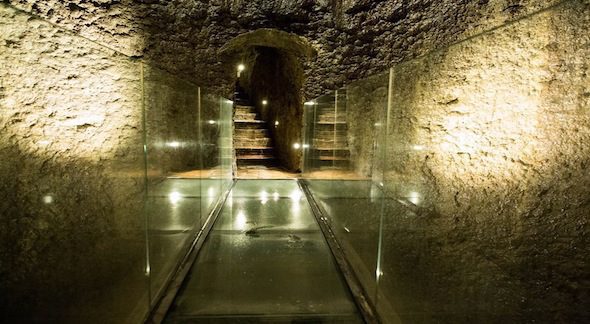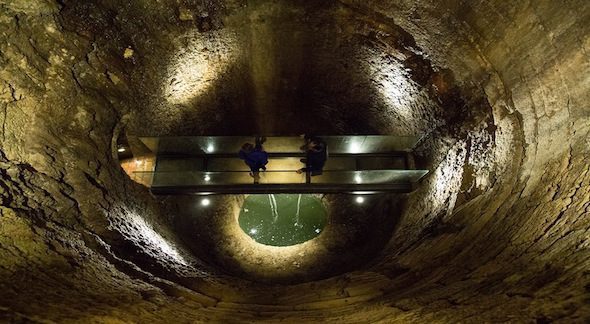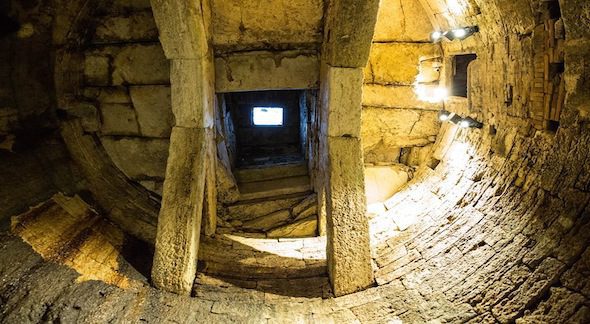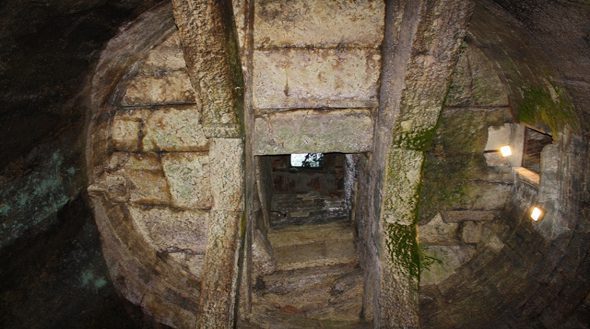A pochi passi da Piazza IV Novembre, nel cuore del centro storico di Perugia, si trova l’ingresso al Pozzo Etrusco: la grandiosa costruzione rappresenta una delle eccellenza della città, simbolo di una storia antichissima che affonda le sue radici nelle epoche più remote.
Capolavoro dell’antica ingegneria idraulica, il Pozzo risale infatti al IV o III secolo a.C. e costituiva il principale serbatoio idrico della città nell’età etrusca e romana.
Il Pozzo è stato riscoperto grazie alle esplorazioni speleo-archeologiche condotte a metà anni ’60, per poi avere un importante restauro in anni recenti. Nel 2017, infine, sono stati apportati lavori di sostituzione della passerella alla base del Pozzo, che oggi presenta una struttura in vetro e ferro molto funzionale, arricchita da un impianto di illuminazione appositamente studiato per valorizzare l’opera etrusca e regalare al visitatore un’esperienza unica.

All’interno del Pozzo Etrusco di Perugia
Il monumentale Pozzo Etrusco di Perugia ha delle dimensioni davvero eccezionali: la cavità cilindrica misura per 12 metri un diametro di 5,6 metri, che poi si riduce a 3 dopo una strozzatura.
Il pozzo raggiunge una profondità di ben 37 metri ed è percorribile grazie ad un geniale sistema di scale. Le dimensioni del manufatto, del tutto inusuali rispetto alle normali caratteristiche delle riserve idriche di età etrusca, fanno ritenere che sia stato concepito come una cisterna.
La parte superiore del tamburo è rivestita di conci di travertino; la copertura è realizzata con due imponenti travature, costituita ognuna da cinque conci monolitici, che a loro volta sorreggono lastroni di travertino.
L’opera testimonia l’elevato grado di civiltà raggiunto dalla comunità perugina già a quell’epoca, poi confermato dagli importanti lavori idraulici effettuati anche nei secoli successivi. Ne sono esempi caratteristici la Fontana Maggiore di Piazza IV Novembre e l’Acquedotto romano che da Monte Pacciano giungeva fino al centro storico di Perugia, ancora ben visibile in vari punti della città.

Visita al Pozzo Etrusco di Perugia: informazioni pratiche
Il Pozzo Etrusco di Perugia è noto anche come Pozzo Sorbello, dal nome della famiglia che tuttora possiede il palazzo antistante. L’ingresso si trova in Piazza Danti 18 e il Pozzo si snoda lungo i sotterranei del Palazzo, con al parte esterna in Piazza Piccinino, proprio di fronte alla Casa Museo Sorbello.
La visita al Pozzo è piuttosto breve ma suggestiva. Si inizia dalla nuova sala d’accoglienza, che ospita anche i resti di un’antica torre medievale, dove è proiettato un video introduttivo con ricostruzioni in 3D che fornisce utili informazioni storico architettoniche grazie alle quali sarà possibile comprendere le dinamiche di costruzione del pozzo e godersi appieno la visita. Dopo essersi affacciati dall’apertura che permette di osservare l’opera dall’alto, la visita prosegue scendendo nel cuore del pozzo, fino alla passerella posizionata a 12 metri sotto terra.
Il biglietto d’ingresso ha un costo di € 3,00 e sono previste riduzioni e gratuità. L’ingresso avviene a piccoli gruppi, a causa delle ristrette dimensioni dei passaggi e la possibile scivolosità dei gradini dovuta alla presenza dell’acqua.
Di seguito, i giorni e orari di apertura:
Da Aprile a metà Luglio
Aperto Lunedì 10.00 – 13.30
Aperto da martedì a domenica 10.00 – 13.30 / 14.30 – 18.00
Da metà Luglio al 17 Settembre
Aperto da lunedì a domenica 10.00 – 13.30 / 14.30 – 18.00
Dal 18 Settembre a Ottobre
Aperto lunedì 10.00 – 13.30
Aperto da martedì a domenica 10.00 – 13.30 / 14.30 – 18.00
Da Novembre a Marzo
Aperto da martedì a domenica 11.00 – 13.30 / 14.30 – 17.00
Per ponti e festività: 10.00 – 13.30 / 14.30 – 18.00

Buona visita al Pozzo Etrusco di Perugia!
Just a few metres far from Fontana Maggiore and Piazza IV Novembre there is the entrance to Pozzo Etrusco (Etruscan Well), an imposing construction of the fourth or third century BC which has exceptional dimensions : 37 meters deep and 5.6 meters in diameter , viable thanks to an ingenious system of stairs.
>> Do you want to visit Perugia? Check it out now of the best hotels in Perugia Italy

>> Do you want to discover Perugia’s Etruscan treasures? Check it out now of the best farmhouses in Perugia.
Also called Pozzo Sorbello, from the name of the noble family that owned the palace above, the monument is an exceptional work of hydraulic engineering, datable to the second half of the third century BC which testifies to the high degree of civilization attained by Perugia population at that time. The top of the drum is covered with travertine blocks, the cover is made from two massive beams, each consisting of five monolithic blocks, which in turn support slabs of travertine. The size of the object, quite unusual compared to the normal characteristics of the Etruscan water reserves, suggests that it was conceived as a cistern.
Walking through a tunnel of the Middle Ages it is possible to come into the well where water veins still flow. On the basis of the coating it is possible to read alphabetic signs, similar to those found in some carved blocks inserted in the walls of the city.
If you’ve decided to visit Perugia and discover Etruscan treasures you should contact now farmhouses near Perugia >> click this link.
Just a few metres far from Fontana Maggiore and Piazza IV Novembre there is the entrance to Pozzo Etrusco (Etruscan Well), an imposing construction of the fourth or third century BC which has exceptional dimensions : 37 meters deep and 5.6 meters in diameter , viable thanks to an ingenious system of stairs.
>> Do you want to visit Perugia? Check it out now of the best hotels in Perugia Italy

>> Do you want to discover Perugia’s Etruscan treasures? Check it out now of the best farmhouses in Perugia.
Also called Pozzo Sorbello, from the name of the noble family that owned the palace above, the monument is an exceptional work of hydraulic engineering, datable to the second half of the third century BC which testifies to the high degree of civilization attained by Perugia population at that time. The top of the drum is covered with travertine blocks, the cover is made from two massive beams, each consisting of five monolithic blocks, which in turn support slabs of travertine. The size of the object, quite unusual compared to the normal characteristics of the Etruscan water reserves, suggests that it was conceived as a cistern.
Walking through a tunnel of the Middle Ages it is possible to come into the well where water veins still flow. On the basis of the coating it is possible to read alphabetic signs, similar to those found in some carved blocks inserted in the walls of the city.
If you’ve decided to visit Perugia and discover Etruscan treasures you should contact now farmhouses near Perugia >> click this link.
Just a few metres far from Fontana Maggiore and Piazza IV Novembre there is the entrance to Pozzo Etrusco (Etruscan Well), an imposing construction of the fourth or third century BC which has exceptional dimensions : 37 meters deep and 5.6 meters in diameter , viable thanks to an ingenious system of stairs.
>> Do you want to visit Perugia? Check it out now of the best hotels in Perugia Italy

>> Do you want to discover Perugia’s Etruscan treasures? Check it out now of the best farmhouses in Perugia.
Also called Pozzo Sorbello, from the name of the noble family that owned the palace above, the monument is an exceptional work of hydraulic engineering, datable to the second half of the third century BC which testifies to the high degree of civilization attained by Perugia population at that time. The top of the drum is covered with travertine blocks, the cover is made from two massive beams, each consisting of five monolithic blocks, which in turn support slabs of travertine. The size of the object, quite unusual compared to the normal characteristics of the Etruscan water reserves, suggests that it was conceived as a cistern.
Walking through a tunnel of the Middle Ages it is possible to come into the well where water veins still flow. On the basis of the coating it is possible to read alphabetic signs, similar to those found in some carved blocks inserted in the walls of the city.
If you’ve decided to visit Perugia and discover Etruscan treasures you should contact now farmhouses near Perugia >> click this link.
Just a few metres far from Fontana Maggiore and Piazza IV Novembre there is the entrance to Pozzo Etrusco (Etruscan Well), an imposing construction of the fourth or third century BC which has exceptional dimensions: 37 meters deep and 5.6 meters in diameter , viable thanks to an ingenious system of stairs.
>> Do you want to visit Perugia? Check it out now of the best hotels in Perugia Italy

>> Do you want to discover Perugia’s Etruscan treasures? Check it out now of the best farmhouses in Perugia.
Also called Pozzo Sorbello, from the name of the noble family that owned the palace above, the monument is an exceptional work of hydraulic engineering, datable to the second half of the third century BC which testifies to the high degree of civilization attained by Perugia population at that time. The top of the drum is covered with travertine blocks, the cover is made from two massive beams, each consisting of five monolithic blocks, which in turn support slabs of travertine. The size of the object, quite unusual compared to the normal characteristics of the Etruscan water reserves, suggests that it was conceived as a cistern.
Walking through a tunnel of the Middle Ages it is possible to come into the well where water veins still flow. On the basis of the coating it is possible to read alphabetic signs, similar to those found in some carved blocks inserted in the walls of the city.
If you’ve decided to visit Perugia and discover Etruscan treasures you should contact now farmhouses near Perugia >> click this link.





Comment (0)